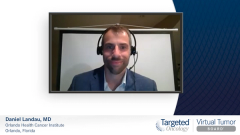
Overview of Prostate Cancer and Treatment Modalities
Experts provide comprehensive insight on prostate cancer, covering its prevalence, subtypes, and the systemic treatment armamentarium.
Episodes in this series

Transcript:
Alan Bryce, MD: Hello, and welcome to this Targeted Oncology™ Virtual Tumor Board titled “Novel Hormonal Therapies in Prostate Cancer.” I’m Dr Alan Bryce. I’m an associate professor of medicine and the chair of division of hematology and oncology in the department of internal medicine at the Mayo Clinic in Phoenix, Arizona. Today I’m joined by Dr Eleni Efstathiou, the section chief of genitourinary medical oncology at Houston Methodist in Houston, Texas; and Dr Daniel Landau, the section chief of hematology and oncology at Orlando Health Cancer Institute [in Orlando, Florida]. In today’s presentation, my colleagues and I will review clinical cases. We’ll discuss approaches to treating patients with prostate cancer, and we’ll share our perspectives on key clinical trial data that may impact our treatment decisions. Thanks for joining us. Let’s get started.
For case 1, [here is] some background information on prostate cancer. This is familiar to most people. Roughly a quarter-million men per year will be diagnosed with prostate cancer in 2021 in the United States. This is going to translate into approximately 34,000 deaths. The pie chart on the right shows the distribution of stages with approximately three-quarters of men being localized, about one-eighth having regional disease, and somewhere around 7%, perhaps having metastatic disease at initial diagnosis. This chart is a conceptualization of the various mechanisms by which prostate cancer starts out hormone-sensitive and can eventually develop into castration-resistant disease.
This diagram was initially presented by Dr [Karen] Knudsen in 2010, but the mechanism and the lessons remain much the same. The selective pressure most often is the antitestosterone hormonal therapy that we administer. That can lead to any number of adaptive changes in the tumor. There can be gain of function, AR [androgen receptor] mutations. There can be aberrant modification of the AR through factors, cytokines, Src, etc. Alternative splicing, which we’ve heard so much about in the last several years leading to…independent activation of the androgen receptor. There can be cofactor perturbations, intracrine androgen synthesis—the tumor producing its own testosterone supply—and of course amplification or overexpression of the androgen receptor.
Regardless of the mechanism by which it happens, the result is the same, and that is restored AR activity even in the low-testosterone environment, leading to cancer progression and recurrent tumor development. This is the CRPC [castration-resistant prostate cancer] state that we talk about in prostate cancer. When we’re thinking about treatment selection, 1 thing you always have to start with is the disease state classification. There’s a hodgepodge of different terms we use, and it’s important to keep these terms in mind when understanding the individual clinical trials and where they fit into the treatment paradigms.
Right off the bat, when we’re defining the disease state for an individual patient, we have to think about metastatic vs nonmetastatic disease. This is a radiographic distinction based on conventional imaging, with CT imaging and technetium bone scans. Of course, the complication with this disease state is that perhaps it’s disappearing with the advent of nuclear medicine and PSMA [prostate-specific membrane antigen]–PET [positron emission tomography] scans. Nevertheless, for clinical trial design and data interpretation, this distinction remains valid. There’s a distinction between castration-sensitive disease and castration-resistant disease. A key distinction is based on whether the progression is happening in the absence or presence of adequate testosterone levels. The conventional definition we use for castration is testosterone of less than 50 ng/dL. Then [there’s a distinction between] high- vs low-risk disease but also high- vs low- volume disease. These are not interchangeable terms. In the clinical trial definition, when we talk about volume, we’re really talking about the CHAARTED definition, which is 4 or more bone metastases or the presence of visceral metastases. When we talk about risk, we’re talking about a somewhat more sophisticated assessment based on the totality of the factors in the disease presentation.
In terms of the classes of agents for the treatment of prostate cancer, there are immunotherapeutic agents, such as sipuleucel-T and pembrolizumab. There are hormonal agents, starting with androgen deprivation therapy and then the more modern antigen receptor pathway inhibitors: enzalutamide, apalutamide, darolutamide, or abiraterone. Of course, there are the earlier generations of these drugs. There’s cytotoxic chemotherapy, docetaxel and cabazitaxel. There are DNA-damaging agents, radium-223 dichloride, olaparib, and rucaparib. Then there’s PSMA-targeting therapy with lutetium-177-PSMA-617, which was recently approved in the United States.
Transcript edited for clarity.










































